ASP.NET Core 学习笔记 第四篇 ASP.NET Core 中的配置
前言
说道配置文件,基本大多数软件为了扩展性、灵活性都会涉及到配置文件,比如之前常见的app.config和web.config。然后再说.NET Core,很多都发生了变化。总体的来说技术在进步,新的方式更加轻量级,具有更好的扩展性,数据源更加多样性。
ASP.NET Core 应用可用的配置提供程序
| 提供程序 | 一下对象提供配置 |
|---|---|
| Azure Key Vault 配置提供程序 | Azure Key Vault |
| Azure 应用配置提供程序 | Azure 应用程序配置 |
| 命令行配置提供程序 | 命令行参数 |
| 自定义配置提供程序 | 自定义源 |
| 环境变量配置提供程序 | 环境变量 |
| 文件配置提供程序 | INI、JSON 和 XML 文件 |
| Key-per-file 配置提供程序 | 目录文件 |
| 内存配置提供程序 | 内存中集合 |
| 用户机密 | 用户配置文件目录中的文件 |
配置提供程序的典型顺序为:
1.appsettings.json
2.appsettings.Environment.json
3.用户机密
4.使用环境变量配置提供程序通过环境变量提供。
5.使用命令行配置提供程序通过命令行参数提供。
注意: 通常的做法是将命令行配置提供程序添加到一系列提供程序的末尾,使命令行参数能够替代由其他提供程序设置的配置。
配置模型三要素
.NET Core的配置系统由三个核心对象构成,分别是IConfiguration、IConfigurationBuilder、IConfigurationSource。
- IConfiguration:读取出来的配置信息最终会转换成一个IConfiguration对象供应用程序使用。
- IConfigurationBuilder:IConfigurationBuilder是IConfiguration对象的构建者。
- IConfigurationSource:则代表配置数据最原始的来源。
文件配置
读取INI文件配置
首先创建一个ASP .NET Core Web API项目,在主目录下添加MyIniConfig.ini文件。
ID=1
Title="INIConfig title"
Name="INIConfig name"
[Logging:LogLevel]
Default=Information
在Program类中读取配置文件
public class Program
{
public static void Main(string[] args)
{
CreateHostBuilder(args).Build().Run();
}
public static IHostBuilder CreateHostBuilder(string[] args) =>
Host.CreateDefaultBuilder(args)
.ConfigureAppConfiguration((hostingContext, config) =>
{
config.Sources.Clear();
var env = hostingContext.HostingEnvironment;
config.AddIniFile("MyIniConfig.ini", optional: true, reloadOnChange: true); config.AddEnvironmentVariables();
if (args != null)
{
config.AddCommandLine(args);
}
})
.ConfigureWebHostDefaults(webBuilder =>
{
webBuilder.UseStartup<Startup>();
});
}
新建一个名为SettingsController的控制器,读取配置文件。
[Route("api/[controller]/[action]")]
[ApiController]
public class SettingsController : ControllerBase
{
private readonly IConfiguration Configuration;
public SettingsController(IConfiguration configuration)
{
Configuration = configuration;
}
public ContentResult INISetting()
{
int id = Configuration.GetValue<int>("ID");
var title = Configuration["Title"];
var defaultLogLevel = Configuration["Logging:LogLevel:Default"];
return Content($"ID:{id}\n" +$"Title:{title}\n"+
$"Default Log Level: {defaultLogLevel}");
}
}
利用PostMan可以看到已经读取到刚刚设置的INI文件。
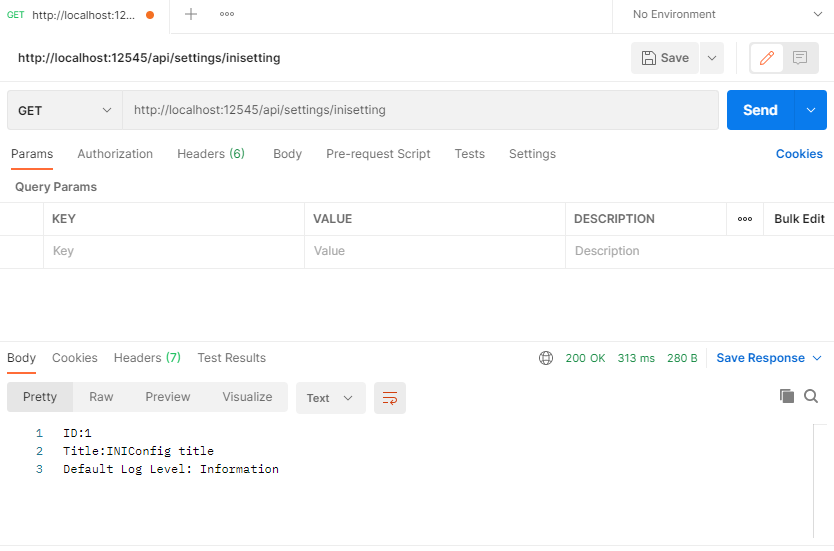
读取Json配置文件。
新建ASP.NET Core Web API项目,在主目录下添加MyJsonConfig.json文件。
{
"ID": "1",
"Title": "My JsonConfig",
"Logging": {
"LogLevel": {
"Default": "Information"
}
}
}
在Program类中读取配置文件
public class Program
{
public static void Main(string[] args)
{
CreateHostBuilder(args).Build().Run();
}
public static IHostBuilder CreateHostBuilder(string[] args) =>
Host.CreateDefaultBuilder(args)
.ConfigureAppConfiguration((hostingContext, config) =>
{
config.Sources.Clear();
var env = hostingContext.HostingEnvironment;
config.AddJsonFile("MyJsonConfig.json", optional: true, reloadOnChange: true);
config.AddEnvironmentVariables();
if (args != null)
{
config.AddCommandLine(args);
}
})
.ConfigureWebHostDefaults(webBuilder =>
{
webBuilder.UseStartup<Startup>();
});
}
新建一个名为SettingsController的控制器,读取配置文件。
[Route("api/[controller]/[action]")]
[ApiController]
public class SettingsController : ControllerBase
{
private readonly IConfiguration Configuration;
public SettingsController(IConfiguration configuration)
{
Configuration = configuration;
}
public ContentResult JsonSetting()
{
int id = Configuration.GetValue<int>("ID");
var title = Configuration["Title"];
var defaultLogLevel = Configuration["Logging:LogLevel:Default"];
return Content($"ID:{id}\n" + $"Title:{title}\n" +
$"Default Log Level: {defaultLogLevel}");
}
}
利用PostMan可以看到已经读取到刚刚设置的Json文件。
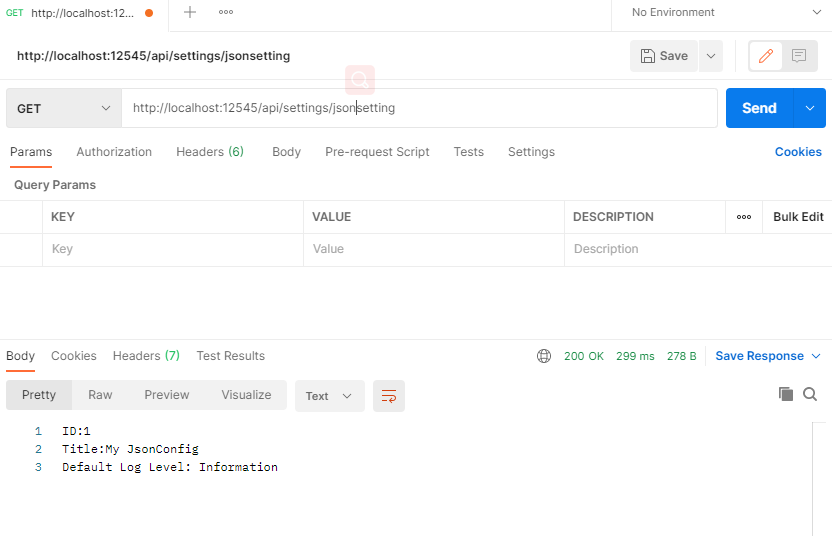
读取XML文件
新建ASP.NET Core Web API项目,在主目录下添加MyXMLConfig.xml文件。
<?xml version="1.0" encoding="utf-8" ?>
<configuration>
<ID>1</ID>
<Title>MyXMLConfig Title</Title>
<Name>MyXMLConfig Name</Name>
<Logging>
<LogLevel>
<Default>Information</Default>
</LogLevel>
</Logging>
</configuration>
在Program类中读取配置文件
public class Program
{
public static void Main(string[] args)
{
CreateHostBuilder(args).Build().Run();
}
public static IHostBuilder CreateHostBuilder(string[] args) =>
Host.CreateDefaultBuilder(args)
.ConfigureAppConfiguration((hostingContext, config) =>
{
config.Sources.Clear();
var env = hostingContext.HostingEnvironment;
config.AddXmlFile("MyXMLConfig.xml", optional: true, reloadOnChange: true);
config.AddEnvironmentVariables();
if (args != null)
{
config.AddCommandLine(args);
}
})
.ConfigureWebHostDefaults(webBuilder =>
{
webBuilder.UseStartup<Startup>();
});
}
新建一个名为SettingsController的控制器,读取配置文件。
[Route("api/[controller]/[action]")]
[ApiController]
public class SettingsController : ControllerBase
{
private readonly IConfiguration Configuration;
public SettingsController(IConfiguration configuration)
{
Configuration = configuration;
}
public ContentResult XmlSetting()
{
int id = Configuration.GetValue<int>("ID");
var title = Configuration["Title"];
var defaultLogLevel = Configuration["Logging:LogLevel:Default"];
return Content($"ID:{id}\n" + $"Title:{title}\n" +
$"Default Log Level: {defaultLogLevel}");
}
}
利用PostMan可以看到已经读取到XML文件的配置。
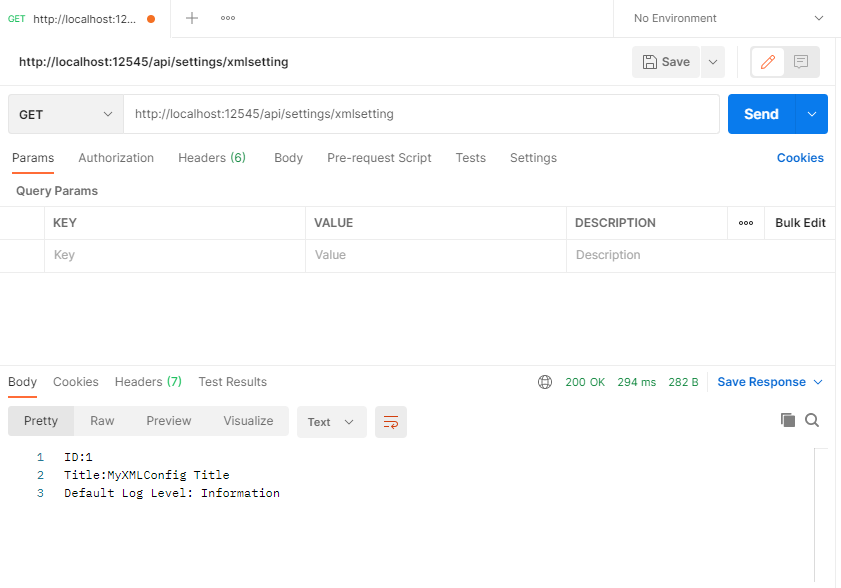
读取配置项的方法
说几个在读取配置项中比较常用的方法,大家可以根据上面例子,自己试一下,这里就不详细讲解了。
GetValue
ConfigurationBinder.GetValue 从配置中提取一个具有指定键的值,并将它转换为指定的类型。在上面的中int id = Configuration.GetValue("ID");就是利用这个方法获取指定类型。
GetSection
IConfiguration.GetSection 会返回具有指定子节键的配置子节。
GetChildren
IConfiguration.GetChildren 方法获取直接后代配置子节。
Exists
ConfigurationExtensions.Exists(IConfigurationSection)确定该部分是否具有 Value 或子级。
将配置绑定到对象
新建ASP.NET Core Web API项目,在主目录下添加MyArray.json文件。
{
"array": {
"entries": {
"0": "value0",
"1": "value1",
"2": "value2",
"3": "value3"
}
}
}
创建一个model。
public class Model
{
public string[] Entries { get; set; }
}
在Program类中读取配置文件
public class Program
{
public static void Main(string[] args)
{
CreateHostBuilder(args).Build().Run();
}
public static IHostBuilder CreateHostBuilder(string[] args) =>
Host.CreateDefaultBuilder(args)
.ConfigureAppConfiguration((hostingContext, config) =>
{
config.Sources.Clear();
var env = hostingContext.HostingEnvironment;
config.AddJsonFile("MyArray.json",optional: true,reloadOnChange: true);
config.AddEnvironmentVariables();
if (args != null)
{
config.AddCommandLine(args);
}
})
.ConfigureWebHostDefaults(webBuilder =>
{
webBuilder.UseStartup<Startup>();
});
}
新建一个名为SettingsController的控制器,读取配置文件。
[Route("api/[controller]/[action]")]
[ApiController]
public class SettingsController : ControllerBase
{
private readonly IConfiguration Configuration;
public SettingsController(IConfiguration configuration)
{
Configuration = configuration;
}
public ContentResult ToModel()
{
array = Configuration.GetSection("array").Get<Model>();
string modelStr = null;
for (int j = 0; j < array.Entries.Length; j++)
{
modelStr += $"Index: {j} Value: {array.Entries[j]} \n";
}
return Content(modelStr);
}
}
利用PostMan可以看到已经读取到绑定到Model的配置。
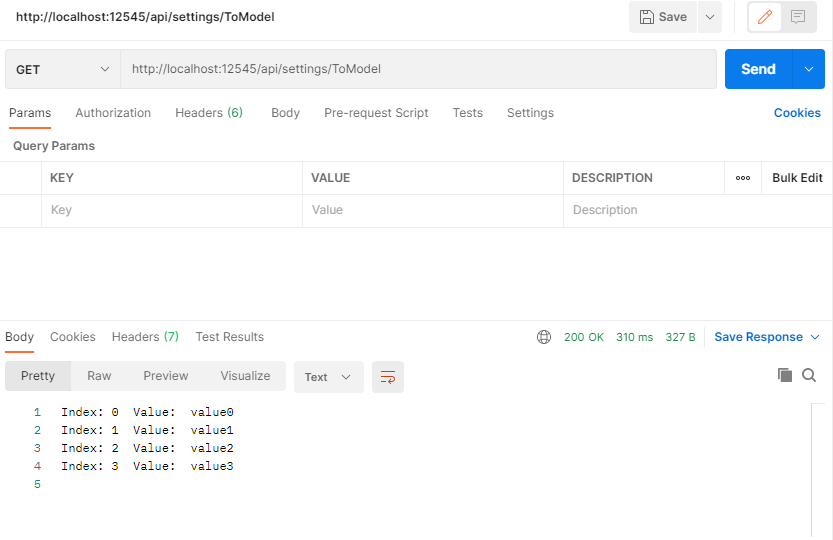
自定义配置
如果上面的方式还不能满足项目要求的话,还可以从数据库中读取配置信息。接下来我们通过实体框架(EF)读取数据库中配置信息(埋个伏笔,后续做个相关教程)。便于操作,这次使用内存数据库做配置源。
首先做一个创建一个实体。
public class EFModel
{
public int ID { get; set; }
public string Name { get; set; }
public string Value { get; set; }
}
添加 EFConfigContext 以存储和访问配置的值。
public class EFConfigContext:DbContext
{
public EFConfigContext(DbContextOptions options) : base(options)
{
}
public DbSet<EFModel> Values { get; set; }
}
创建用于实现 IConfigurationSource 的类。
public class EFConfigurationSource : IConfigurationSource
{
private readonly Action<DbContextOptionsBuilder> _optionsAction;
public EFConfigurationSource(Action<DbContextOptionsBuilder> optionsAction)
{
_optionsAction = optionsAction;
}
public IConfigurationProvider Build(IConfigurationBuilder builder)
{
return new EFConfigurationProvider(_optionsAction);
}
}
通过从 ConfigurationProvider 继承来创建自定义配置提供程序。 当数据库为空时,配置提供程序将对其进行初始化。
public class EFConfigurationProvider:ConfigurationProvider
{
Action<DbContextOptionsBuilder> OptionsAction { get; }
public EFConfigurationProvider(Action<DbContextOptionsBuilder> optionsAction)
{
OptionsAction = optionsAction;
}
public override void Load()
{
var builder = new DbContextOptionsBuilder<EFConfigContext>();
OptionsAction(builder);
using (var dbContext =new EFConfigContext(builder.Options))
{
dbContext.Database.EnsureCreated();
Data =!dbContext.Values.Any()?CreateAndSaveValues(dbContext) : dbContext.Values.ToDictionary(c => c.Name, c => c.Value);
}
}
private static IDictionary<string, string> CreateAndSaveValues(EFConfigContext dbContext)
{
var configValues = new Dictionary<string, string>(StringComparer.OrdinalIgnoreCase)
{
{"name1","value1" },
{"name2","value2" },
{"name3","value3" }
};
dbContext.Values.AddRange(configValues.Select(v => new EFModel
{
Name = v.Key,
Value = v.Value
}).ToArray());
dbContext.SaveChanges();
return configValues;
}
}
使用 AddEFConfiguration 扩展方法将配置源添加到 ConfigurationBuilder。
public static class EFExtensions
{
public static IConfigurationBuilder AddEFConfiguration(this IConfigurationBuilder builder,Action<DbContextOptionsBuilder> optionsAction)
{
return builder.Add(new EFConfigurationSource(optionsAction));
}
}
在 Program.cs 中使用自定义的 EFConfigurationProvider:
public class Program
{
public static void Main(string[] args)
{
CreateHostBuilder(args).Build().Run();
}
public static IHostBuilder CreateHostBuilder(string[] args) =>
Host.CreateDefaultBuilder(args)
.ConfigureAppConfiguration((hostingContext, config) =>
{
config.Sources.Clear();
var env = hostingContext.HostingEnvironment;
config.AddEFConfiguration(
options => options.UseInMemoryDatabase("InMemoryDb"));
config.AddEnvironmentVariables();
if (args != null)
{
config.AddCommandLine(args);
}
})
.ConfigureWebHostDefaults(webBuilder =>
{
webBuilder.UseStartup<Startup>();
});
}
在Startup中通过依赖注入添加据库上下文服务,向控制器提供服务。
public class Startup
{
public Startup(IConfiguration configuration)
{
Configuration = configuration;
}
public IConfiguration Configuration { get; }
public void ConfigureServices(IServiceCollection services)
{
services.AddDbContext<EFConfigContext>(opt => opt.UseInMemoryDatabase("InMemoryDb"));
services.AddControllers();
}
public void Configure(IApplicationBuilder app, IWebHostEnvironment env)
{
if (env.IsDevelopment())
{
app.UseDeveloperExceptionPage();
}
app.UseRouting();
app.UseAuthorization();
app.UseEndpoints(endpoints =>
{
endpoints.MapControllers();
});
}
}
在控制器中注入服务,读取内存数据库中的数据。
[Route("api/[controller]/[action]")]
[ApiController]
public class SettingsController : ControllerBase
{
private readonly EFConfigContext _efDbContext;
public SettingsController( EFConfigContext efDbContext)
{
_efDbContext = efDbContext;
}
public ActionResult<IEnumerable<EFModel>> EFSetting()
{
List<EFModel> list = _efDbContext.Values.ToList();
return list;
}
}
利用PostMan可以看到已经读取到我们自定义的配置源。
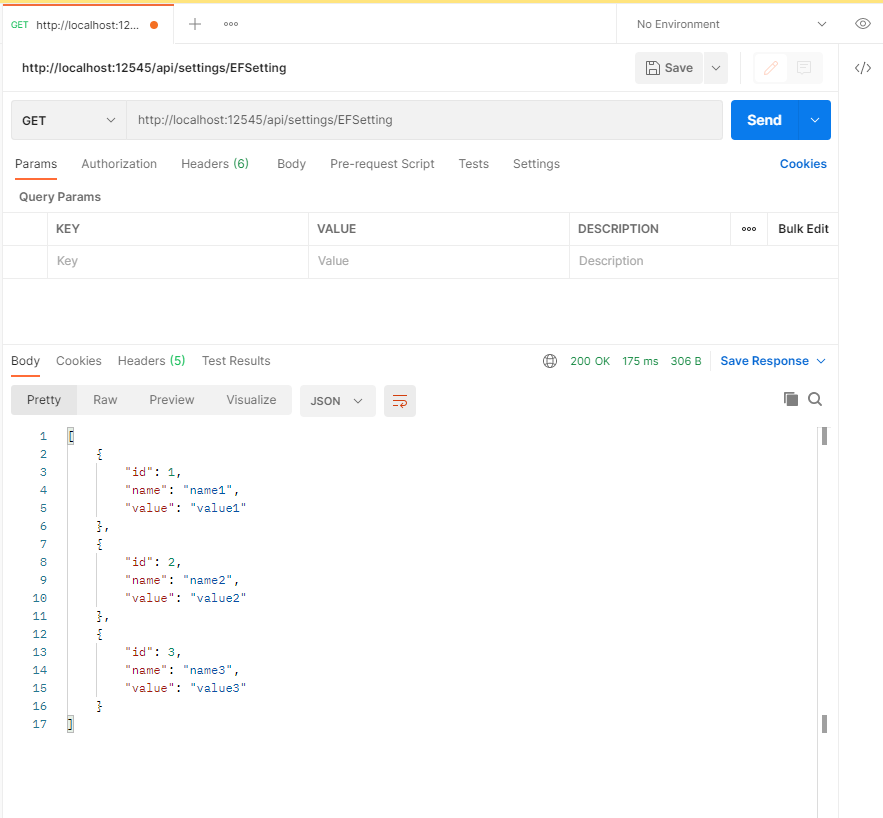
加一张整体的项目结构,方便大家理解。
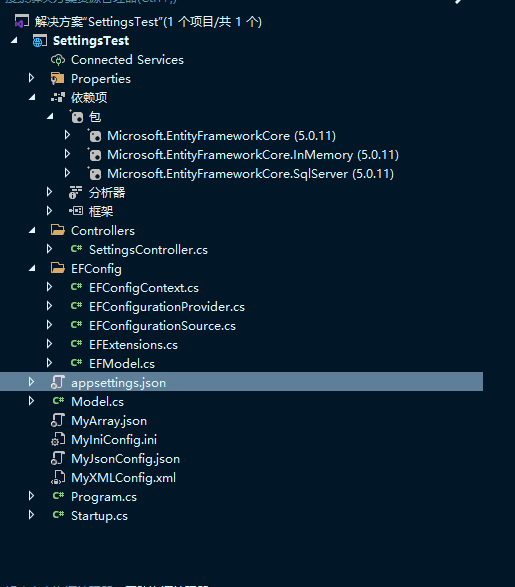
最近疫情有些反复,出门做好个人防护,玩耍时别忘记学习。最后祝大家周末愉快!
ASP.NET Core 学习笔记 第四篇 ASP.NET Core 中的配置的更多相关文章
- ASP.NET Core 学习笔记 第五篇 ASP.NET Core 中的选项
前言 还记得上一篇文章中所说的配置吗?本篇文章算是上一篇的延续吧.在 .NET Core 中读取配置文件大多数会为配置选项绑定一个POCO(Plain Old CLR Object)对象,并通过依赖注 ...
- VSTO学习笔记(四)从SharePoint 2010中下载文件
原文:VSTO学习笔记(四)从SharePoint 2010中下载文件 上一次我们开发了一个简单的64位COM加载项,虽然功能很简单,但是包括了开发一个64位COM加载项的大部分过程.本次我们来给CO ...
- 路由其实也可以很简单-------Asp.net WebAPI学习笔记(一) ASP.NET WebApi技术从入门到实战演练 C#面向服务WebService从入门到精通 DataTable与List<T>相互转换
路由其实也可以很简单-------Asp.net WebAPI学习笔记(一) MVC也好,WebAPI也好,据我所知,有部分人是因为复杂的路由,而不想去学的.曾经见过一位程序猿,在他MVC程序中, ...
- ASP.NET MVC 学习笔记-7.自定义配置信息 ASP.NET MVC 学习笔记-6.异步控制器 ASP.NET MVC 学习笔记-5.Controller与View的数据传递 ASP.NET MVC 学习笔记-4.ASP.NET MVC中Ajax的应用 ASP.NET MVC 学习笔记-3.面向对象设计原则
ASP.NET MVC 学习笔记-7.自定义配置信息 ASP.NET程序中的web.config文件中,在appSettings这个配置节中能够保存一些配置,比如, 1 <appSettin ...
- ASP.NET MVC 学习笔记-2.Razor语法 ASP.NET MVC 学习笔记-1.ASP.NET MVC 基础 反射的具体应用 策略模式的具体应用 责任链模式的具体应用 ServiceStack.Redis订阅发布服务的调用 C#读取XML文件的基类实现
ASP.NET MVC 学习笔记-2.Razor语法 1. 表达式 表达式必须跟在“@”符号之后, 2. 代码块 代码块必须位于“@{}”中,并且每行代码必须以“: ...
- Asp.Net Core学习笔记:入门篇
Asp.Net Core 学习 基于.Net Core 2.2版本的学习笔记. 常识 像Django那样自动检查代码更新,自动重载服务器(太方便了) dotnet watch run 托管设置 设置项 ...
- .net core学习笔记,组件篇:服务的注册与发现(Consul)初篇
1.什么是服务注册中心? 在学习服务注册与发现时,我们要先搞明白到底什么是服务注册与发现. 在这里我举一个生活中非常普遍的例子——网购来简单说明,网购在我们日常生活中已经是非常普遍了,其实网购中的(商 ...
- Asp.net core Identity + identity server + angular 学习笔记 (第四篇)
来说说 RBAC (role based access control) 这是目前全世界最通用的权限管理机制, 当然使用率高并不是说它最好. 它也有很多局限的. 我们来讲讲最简单的 role base ...
- ASP.NET Core 学习笔记 第三篇 依赖注入框架的使用
前言 首先感谢小可爱门的支持,写了这个系列的第二篇后,得到了好多人的鼓励,也更加坚定我把这个系列写完的决心,也能更好的督促自己的学习,分享自己的学习成果.还记得上篇文章中最后提及到,假如服务越来越多怎 ...
随机推荐
- C++打字小游戏
从@小蔡编程 那里获得的灵感,原文地址:https://www.cnblogs.com/xiaocaibiancheng/p/15158997.html 那篇文章是说python写打字游戏的,本文就用 ...
- Python+Selenium:初步使用Chrome谷歌浏览器
·············环境结合··············· 我的环境:window10 64位 Python 3.7 32-bit selenium 3.141.0 Goo ...
- Python新手的奇技淫巧,掌握在手的充实感
以下是我长久以来收集的一些Python实用技巧和工具,希望能对刚学习Python的新手有所帮助. 1.交换变量 x = 6 y = 5 x, y = y, x print x >>> ...
- PHP中国际化的字符串比较对象
在 PHP 中,国际化的功能非常丰富,包括很多我们可能都不知道的东西其实都非常有用,比如说今天要介绍的这一系列的字符排序和比较的功能. 排序 正常来说,如果我们对数组中的字符进行排序,按照的是字符的 ...
- dede图片集关联的数据库用表:
如果在本地的环境中,安装目录不在根目录,搬到外网上的时候,就需要对数据库里的图片路径数据进行字段替换: dede图片集关联的数据库用表:1.dede_addonimages 2.dede_arctin ...
- Jmeter系列(14)- Setup与tearDown线程组
与普通线程组区别 #Setup线程组:在普通线程组执⾏前触发 #tearDown线程组:在普通线程组执⾏后触发 线程组属性配置详情完全⼀致 使⽤策略建议 #Setup 线程组 – 压测执⾏准备阶段,准 ...
- spring入门1-IOC和DI
1.概述 1.1.简介 Spring是分层的 Java SE/EE应用 full-stack 轻量级开源框架,以 IoC(Inverse Of Control:反转控制)和 AOP(Aspect Or ...
- mysql 不常用的存储引擎
csv 数据文件可以编辑;每一列不能为空,不支持索引:文件保存数据,cat可以查看数据;用处:数据交换中间表--excel表导入数据等; Archive 对表数据进行压缩,磁盘i/o减少:节省空间;只 ...
- linux 脚本--守护进程
#/bin/bash #队列的守护进程 Date = `date +"%F-%H:%M:%S"` XMML = "/var/www/html/xiangmu" ...
- AT4144-[ARC098D]Donation【Kruskal重构树,dp】
正题 题目链接:https://www.luogu.com.cn/problem/AT4144 题目大意 \(n\)个点\(m\)条边的一张无向联通图,每个点有两个值\(a_i,b_i\).表示经过该 ...
